Paralysis Treatment : A loss or reduction of voluntary muscle power is referred to as paralysis. Diseases that alter the structure or functioning of neural or muscular tissue can cause paralysis, as can those brought on by metabolic imbalances that impair nerve or neuromuscular function.
Depending on the underlying cause, paralysis may only impact a small portion of the human body or a particular muscle group.
Hemiplegia is the medical term for a condition in which just a single area of an individual is afflicted. In other cases, the consequences could affect both sides of the body, resulting in diplegia or bilateral hemiplegia.
Paraplegia is the term used to describe paralysis that solely affects the lower extremities. Quadriplegia is a condition that affects all four limbs. The decrease of strength of muscles in a body portion is commonly referred to as palsy.
Why Does Paralysis Occur?
Damage to the spinal cord or to the nerves that supply it, rather than injury to the afflicted area, nearly invariably results in paralysis. The following are some examples of causes of paralysis in the body:
Injury to the nerves of the spinal cord results in the inability of the central nervous system to transmit or receive impulses to the location through which these nerves are supposed to connect.
Brain Injuries: The capability of the brain to transmit and receive messages to other areas of the body is hampered by damage to the brain, such as brain lesions and traumatic blows to the brain’s surface.
Non-traumatic Injuries: These can include tumors, strokes, and injury to the brain or spinal cord due to oxygen deprivation, which can paralyze a part of the body.
What Are The Symptoms of Paralysis?
The full or a portion of the body that is affected cannot be moved by those who experience paralysis attacks.
The following are the main symptoms that practically everyone in pain may experience:
- Unwilled twitches or spasms
- Muscle tremor
- Muscle numbness in the afflicted areas
- Indications of muscle loss, such as muscular atrophy
- Muscle pain
- Stiffness
Grading of Paralysis:
The grading of The Medical Research Council is based on the muscle strength of an individual. According to the factors that follow, muscular weakening severity can be divided into several “Grades”:
- Grade 0: There is no contraction of muscles or movement.
- Grade 1: There is a little contraction, but there is no movement in the joints.
- Grade 2: Elimination of gravity allows for the movement of joints.
- Grade 3: Resistance other than gravity, but not more resistance.
- Grade 4: Moving with less force than normal in the face of external resistance.
- Grade 5: Strength is average at this grade.
Medical experts claim that depending on this grade, a suitable yoga regimen can be recommended and practiced:
Grade 0 or no movement: Observe that the patient continues to breathe at grade 0. Therefore, practicing deep ujjayi breaths and yoga nidra for just a few days will result in positive effects.
Grades 1 and 2: In this grade, you can do a variety of mudra pranayama’s using the chin mudra and the maha mudra.
One can directly assist the individual to put their fingers in a mudra posture and keep it up to take a few deep breaths if they are unable to move their fingers. This contributes to improving muscle strength.
Grades 3 and 4: Nearly all asanas are possible for them in a typical manner. The muscle strength required to maintain postures is generally low, but with breathing practices, the strength increases and can eventually reach up to the normal strengthening of muscles.
If you or a loved one is experiencing paralysis, it is crucial to seek ayurvedic paralysis treatment In India and need attention as soon as possible.
How Long Will it Take Paralyzed Patients To Recover with Yoga?
The reason for the paralysis will impact how long it will take to recover. It takes more time because the underlying cause must be treated when a neurological cause or cancer is blocking the transmission of nerves.
Yoga should be practiced after ruling out the requirement for surgery in cases with spinal injuries. If high blood pressure is the root of the problem, yoga and meditation must be used to lower the level of blood pressure.
The asanas will vary depending on the condition of the body parts impacted, thus seeking advice from a certified yoga teacher is suggested.

